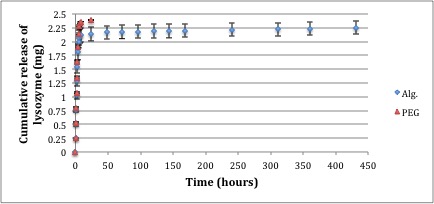Introduction: Smart polymeric hydrogels are used for controlled drug delivery because these systems have sustained drug release kinetics that can be triggered by external stimuli[1]. We hypothesize that by incorporating aptamers (small single stranded nucleic acids[2]) with polymeric hydrogels, we can create protein triggered release systems that deliver in a sustained manner to help optimize protein therapies. The objective of this research is to synthesize covalently cross-linked alginate and 4-armed poly(ethylene glycol) (PEG) hydrogels that are coated with aptamer-modified polymers for the development of bio-responsive materials and to evaluate their release properties.
Methods: To synthesize covalently cross-linked hydrogels, 4-armed PEG (10%w/v) or alginate (3% w/v) was cross-linked with PEG-diamine in MES buffer (pH=6), using 1-ethyl-3-(3-dimethylaminopropyl)carbodiimide (EDC) and N-hydroxysuccinimide (NHS)[3] in a molar ratio of 1:1:2 for PEG and 0.5:1:2 for alginate hydrogels at room temperature (21°C) for 24 hours. The resulting hydrogels were then punched into 5mm diameter disks with a thickness of 1mm, and soaked in water for 24 hours to remove unreacted PEG-diamine and reaction side-products.
Swelling studies were conducted by placing hydrogels in phosphate buffer saline solution (PBS) at room temperature for 24 hours. To determine the efficiency of the reaction, the ninhydrin assay was used to measure unreacted amines in solution and within the hydrogels. Lysozyme was loaded into the hydrogels by swelling dried gels in a solution of 0.33 mg/mL lysozyme in PBS for 24 hours. Lysozyme was then released into 1ml PBS (pH=7.4) at 37°C under shaking. The water content of the hydrogels was determined by weighing the hydrogels when dry and when swollen for 24 hours in PBS.
Results and Discussion: The ninhydrin assay determined that 76.8± 0.6% of the cross-linker reacted to the 4-armed PEG and 4.2 ± 0.3% to the alginate. Although alginate reacted with little cross-linker, a hydrogel formed and swelled to a similar degree as the 4-armed PEG gels. Alginate hydrogels were 97.82 ± 0.21% water and PEG hydrogel were 96.06 ± 0.25%.
Figure 1 shows the release profile of lysozyme from both 4-armed PEG and alginate hydrogels over a period of 450 hours. During release from PEG hydrogels, a visible burst effect occurred followed by a short sustained release over 24 hours. This release is beneficial for drug administration strategies when high rates of delivery are desirable[4]. Alginate gels also showed a burst affect, followed by a sustained release rate of 0.2 μg/hour (ongoing work). Sustained release is desirable as it minimizes drug side affects and maximizes drug efficiency for long lasting conditions such as cancer and chronic pain[5],[6].
Current work includes developing coatings with aptamer-modified polymer solutions, so that release will occur only when triggered by specific proteins in solution.

Figure 1: The cumulative release of lysozyme from 3% w/v PEG and 10% w/v alginate hydrogels into PBS (37°C).
Conclusion: By using the carbodiimide reaction we were able to covalently crosslink alginate and 4-armed PEG into hydrogels. Alginate hydrogels were able to deliver protein in a sustained manner for a period of time over 432 hours. Future work will focus on coatings to trigger release from these gels in response to specific proteins, using aptamers.
This work was supported by a Natural Science and Research Council of Canada grant and scholarship.
References:
[1] Soppimath, K. S., et al. "Stimulus-responsive “smart” hydrogels as novel drug delivery systems." Drug Development and Industrial Pharmacy 28.8 (2002): 957-974.
[2] Mayer, Günter. "The chemical biology of aptamers." Angewandte Chemie International Edition 48.15 (2009): 2672-2689.
[3] Eiselt, Petra, Kuen Yong Lee, and David J. Mooney. "Rigidity of two-component hydrogels prepared from alginate and poly (ethylene glycol)-diamines." Macromolecules 32.17 (1999): 5561-5566.
[4] Huang, Xiao, and Christopher S. Brazel. "On the importance and mechanisms of burst release in matrix-controlled drug delivery systems." Journal of controlled release 73.2 (2001): 121-136.
[5] Samanta, Devleena, Jana L. Meiser, and Richard N. Zare. "Polypyrrole nanoparticles for tunable, pH-sensitive and sustained drug release." Nanoscale 7.21 (2015): 9497-9504.
[6] Zhu, Junmin, and Roger E. Marchant. "Design properties of hydrogel tissue-engineering scaffolds." Expert review of medical devices 8.5 (2011): 607-626.